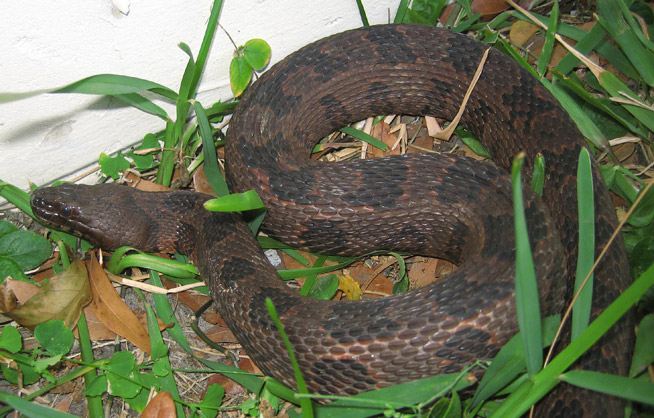
Biology:
Brown Water Snakes are semi-aquatic in nature and have a number of different names including water pilot, great water snake, false moccasin, aspic, pied water snake, water rattler, water rattle and southern water snake to name a few. Their scientific name is Nerodia Tqaxispilota.
The body of the Brown Water Snake is quite bulky. The neck is thin as compared to the head. It is brown or rusty brown in color and has around 25 dark colored square blotches on its back. These sports are present on the side of the belly as well and also run from the eyes to the jaw. The belly color varies from brown to yellow with the presence of black crescents and brown splotches.
They measure 30 to 60 inches in length while the longest one ever recorded stood at 70 inches. Males are smaller and lighter as compared to females. Eyes and nostrils are placed on top of the head in such a way that it is able to see and breathe by bringing just a little portion of the head above water level while rest of the body stay submerged.
The thin neck and broad face structure gives them a diamond-headed appearance. About 25 to 33 rows of dorsal scales are present in the middle part of the body.
Habitat:
Brown water snakes lives in water. They also come out very often and can stay in the nearby areas. They are found in large streams and rivers in and around California, southern Virginia and Florida. They are also found in the coastal plains of Georgina. They are common in flowing waters including black water cypress creeks and canals. The habitats are usually surrounded by overhanging vegetation, rocky river banks and emergent snags. They are quite common in bottomland forests, hardwood hammocks, tidal marshes and saw grass prairies.
Behavior:
Brown Water Snakes are active during the days as well as nights. They are often found basking on the branches of trees that are right above the flowing water. When not hunting, this is usually how they spend their days. This gives them the option of diving in the water and swimming away in case there is any danger. Sometimes, you may even find more than one snake basking together. They are also quick to bite back hard in case they feel any kind of danger from anyone. They are not poisonous but the bite is strong enough to put you into a lot of pain.
They are excellent swimmers and prefer travelling in water as compared to land. They are also brilliant climbers and are known to climb as high as 20 feet on tree branches and other vegetation.
Diet:
Brown Water Snakes like eating fish. They are also known to consume frogs, earthworms and rodents. Females are not able to hunt during the pregnancy due to extra weight and thus store reserves well in advance for the duration of their pregnancy.
They can also consume other snakes that are smaller in size. They don’t usually care for catfishes because their spines can cause them a lot of pain. You can easily spot a Brown Water Snake with the spine of a catfish protruding from their body. The spine breaks away after some time and the wound is healed.
Reproduction:
The snake is known to mate during the spring season from April to May. Mating takes place either on the branches of trees or on land. In late summers, the females give birth to 20 to 60 young ones. Female snakes carry the eggs inside her during the pregnancy.
The pregnancy is not initiated by the deposition of semen but instead by the ovulation. The sperms might stay in the cloaca of inseminated female for months without initiating pregnancy. This is the reason why they do not have a gestation period.
The hatching process is completed inside the body and live young ones are born. They are 7 to 10 inches in length with the males longer and bigger in size than the females. During the first three years of age, they grow very rapidly in size. They are known to live for around six years.
The Brown Water Snakes are often mistaken with cottonmouths that are poisonous.
Below are some other species of snake that may look like a Brown Water Snake:
Copperhead Snake
Cottonmouth Snake
Water Moccasin
Northern Water Snake
Brown Water Snake
Mud Snake
Many people want to know how to kill a Brown Water Snake, but you don't need to. The
best way to get rid of Brown Water Snakes is to simply leave them alone. You can also
use a Brown Water Snake trap to catch them - that's one of the best ways for how to
remove Brown Water Snake. For more information, go to my
Snake Removal - How to Get Rid of Snakes home page.